Blog & Latest Updates
Fly Fishing Articles
Insects by Common Name


Animal Kingdom Animalia (Animals)
Taxonomic Navigation -?-
Kingdom Animalia (Animals)
| Phylum in Animalia | ||
| AnnelidaWorms and Leeches | 0 | 2 |
| ArthropodaArthropods | 0 | 122 |
| ChordataVertebrates | 0 | 4 |
| Mollusca | 0 | 6 |
| PlatyhelminthesFlatworms | 0 | 0 |
Common Name
| Match | Common Name |
| Animals |
This is page 6 of specimens of Animalia. Visit the main Animalia page for:
- The behavior and habitat of Animalia.
- 131 underwater pictures of Animalia.
Pictures of 1264 Animal Specimens:
Male Ephemerella invaria (Sulphur Dun) Mayfly Spinner View 12 Pictures
View 12 Pictures
 View 12 Pictures
View 12 PicturesCollected June 3, 2005 from the Teal River in Wisconsin
Added to Troutnut.com by Troutnut on May 24, 2006
Added to Troutnut.com by Troutnut on May 24, 2006
Male Ephemerella aurivillii Mayfly Dun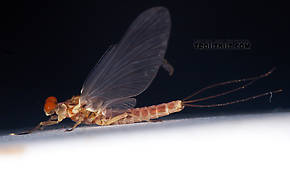 View 14 PicturesThis is the most widespread species of Ephemerella, and also the most abundant in some places, but nobody I've talked to seemed to know what its duns looked like, and there were no pictures of its duns online or in any angling books. That mystery is solved with this male dun, which hatched from a definitively identified nymph.
View 14 PicturesThis is the most widespread species of Ephemerella, and also the most abundant in some places, but nobody I've talked to seemed to know what its duns looked like, and there were no pictures of its duns online or in any angling books. That mystery is solved with this male dun, which hatched from a definitively identified nymph.
 View 14 PicturesThis is the most widespread species of Ephemerella, and also the most abundant in some places, but nobody I've talked to seemed to know what its duns looked like, and there were no pictures of its duns online or in any angling books. That mystery is solved with this male dun, which hatched from a definitively identified nymph.
View 14 PicturesThis is the most widespread species of Ephemerella, and also the most abundant in some places, but nobody I've talked to seemed to know what its duns looked like, and there were no pictures of its duns online or in any angling books. That mystery is solved with this male dun, which hatched from a definitively identified nymph.Brachycentrus appalachia (Apple Caddis) Caddisfly Adult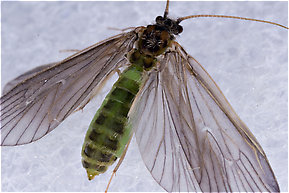 View 9 PicturesThe wings of this specimen were pale tan, almost white, when I collected it, and the body was of the lighter "apple green" from which this species gets its common name. Everything turned much darker by the time I got it home and under the camera.
View 9 PicturesThe wings of this specimen were pale tan, almost white, when I collected it, and the body was of the lighter "apple green" from which this species gets its common name. Everything turned much darker by the time I got it home and under the camera.
The wings look even darker in some of these pictures because the background is black and the wings are unusually translucent. You can see that in one of the pictures where the body easily through the wings. They're really a light, translucent gray, which is still far from the pale tan of the same fly when it was freshly emerged.
 View 9 PicturesThe wings of this specimen were pale tan, almost white, when I collected it, and the body was of the lighter "apple green" from which this species gets its common name. Everything turned much darker by the time I got it home and under the camera.
View 9 PicturesThe wings of this specimen were pale tan, almost white, when I collected it, and the body was of the lighter "apple green" from which this species gets its common name. Everything turned much darker by the time I got it home and under the camera.The wings look even darker in some of these pictures because the background is black and the wings are unusually translucent. You can see that in one of the pictures where the body easily through the wings. They're really a light, translucent gray, which is still far from the pale tan of the same fly when it was freshly emerged.
Collected May 15, 2007 from the West Branch of the Delaware River in New York
Added to Troutnut.com by Troutnut on May 18, 2007
Added to Troutnut.com by Troutnut on May 18, 2007
Neophylax (Autumn Mottled Sedges) Caddisfly Larva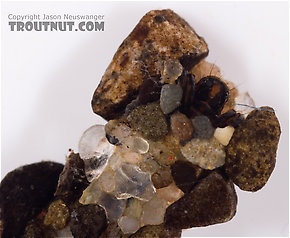 View 9 Pictures
View 9 Pictures
 View 9 Pictures
View 9 PicturesCollected March 30, 2007 from Fall Creek in New York
Added to Troutnut.com by Troutnut on April 2, 2007
Added to Troutnut.com by Troutnut on April 2, 2007
Male Drunella doddsii (Western Green Drake) Mayfly Dun View 13 Pictures
View 13 Pictures
 View 13 Pictures
View 13 PicturesCollected July 17, 2011 from the Gulkana River in Alaska
Added to Troutnut.com by Troutnut on July 20, 2011
Added to Troutnut.com by Troutnut on July 20, 2011
Cheumatopsyche (Little Sister Sedges) Caddisfly Pupa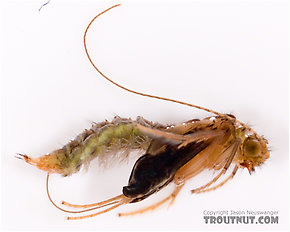 View 10 PicturesThis is the first fully formed caddis pupa (technically, a pharate adult (Pharate adult: Caddisflies are considered to be pupae during their transformation from larva into adult. This transformation is complete before they're ready to emerge. The emerging insect we imitate with the "pupa" patterns we tie is technically called a pharate adult. It is a fully-formed adult caddisfly with one extra layer of exoskeleton surrounding it and restricting its wings.)) that I've collected and photographed alive and healthy. I'll put a video of this specimen online soon, too.
View 10 PicturesThis is the first fully formed caddis pupa (technically, a pharate adult (Pharate adult: Caddisflies are considered to be pupae during their transformation from larva into adult. This transformation is complete before they're ready to emerge. The emerging insect we imitate with the "pupa" patterns we tie is technically called a pharate adult. It is a fully-formed adult caddisfly with one extra layer of exoskeleton surrounding it and restricting its wings.)) that I've collected and photographed alive and healthy. I'll put a video of this specimen online soon, too.
 View 10 PicturesThis is the first fully formed caddis pupa (technically, a pharate adult (Pharate adult: Caddisflies are considered to be pupae during their transformation from larva into adult. This transformation is complete before they're ready to emerge. The emerging insect we imitate with the "pupa" patterns we tie is technically called a pharate adult. It is a fully-formed adult caddisfly with one extra layer of exoskeleton surrounding it and restricting its wings.)) that I've collected and photographed alive and healthy. I'll put a video of this specimen online soon, too.
View 10 PicturesThis is the first fully formed caddis pupa (technically, a pharate adult (Pharate adult: Caddisflies are considered to be pupae during their transformation from larva into adult. This transformation is complete before they're ready to emerge. The emerging insect we imitate with the "pupa" patterns we tie is technically called a pharate adult. It is a fully-formed adult caddisfly with one extra layer of exoskeleton surrounding it and restricting its wings.)) that I've collected and photographed alive and healthy. I'll put a video of this specimen online soon, too.Collected April 14, 2007 from Cayuta Creek in New York
Added to Troutnut.com by Troutnut on April 22, 2007
Added to Troutnut.com by Troutnut on April 22, 2007
Pteronarcys proteus (Salmonfly) Stonefly Nymph View 10 Pictures
View 10 Pictures
 View 10 Pictures
View 10 PicturesCollected April 19, 2006 from Mongaup Creek in New York
Added to Troutnut.com by Troutnut on April 21, 2006
Added to Troutnut.com by Troutnut on April 21, 2006
Cinygmula subaequalis (Small Gordon Quill) Mayfly Nymph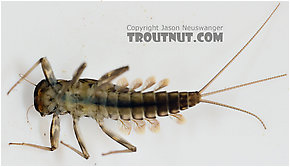 View 10 PicturesThis nymph is missing a few gills, but is otherwise in good shape. It was the only one of its species which turned up in my sample.
View 10 PicturesThis nymph is missing a few gills, but is otherwise in good shape. It was the only one of its species which turned up in my sample.
 View 10 PicturesThis nymph is missing a few gills, but is otherwise in good shape. It was the only one of its species which turned up in my sample.
View 10 PicturesThis nymph is missing a few gills, but is otherwise in good shape. It was the only one of its species which turned up in my sample.Collected May 29, 2007 from Paradise Creek in Pennsylvania
Added to Troutnut.com by Troutnut on June 4, 2007
Added to Troutnut.com by Troutnut on June 4, 2007
Male Epeorus pleuralis (Quill Gordon) Mayfly Dun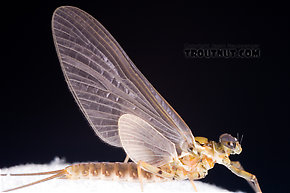 View 9 PicturesI kept this specimen after photographing it and it molted into a spinner in perfect condition, which I photographed here.
View 9 PicturesI kept this specimen after photographing it and it molted into a spinner in perfect condition, which I photographed here.
 View 9 PicturesI kept this specimen after photographing it and it molted into a spinner in perfect condition, which I photographed here.
View 9 PicturesI kept this specimen after photographing it and it molted into a spinner in perfect condition, which I photographed here.Collected April 30, 2007 from Dresserville Creek in New York
Added to Troutnut.com by Troutnut on May 3, 2007
Added to Troutnut.com by Troutnut on May 3, 2007
Male Epeorus albertae (Pink Lady) Mayfly Spinner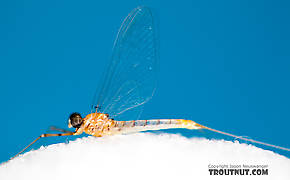 View 14 Pictures
View 14 Pictures
 View 14 Pictures
View 14 PicturesCollected July 11, 2017 from the North Fork Stillaguamish River in Washington
Added to Troutnut.com by Troutnut on July 12, 2017
Added to Troutnut.com by Troutnut on July 12, 2017
Top 10 Fly Hatches
Top Gift Shop Designs
Eat mayflies.
Top Insect Specimens
Miscellaneous Sites
Troutnut.com is copyright © 2004-2024 Jason
Neuswanger (email Jason). See my FAQ for information about use of my images.
 privacy policy
privacy policy
